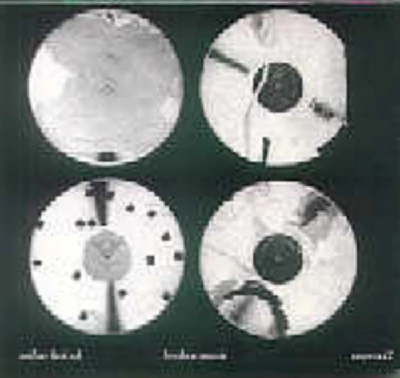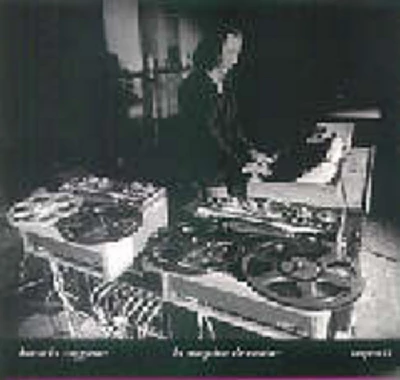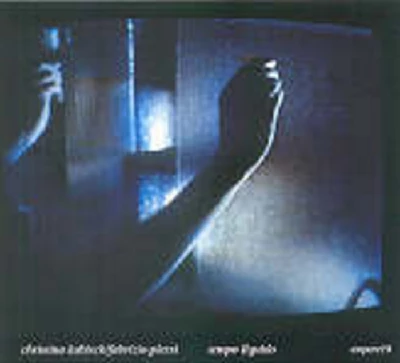Miscellaneous
-
Broken Music : Clawing the Eyes Out of Mona Lisa
published: 21 /
3 /
2002

David McNamee finds himself smitten with three beautifully packaged CDs from the Chicago electronic label, Ampersand, and tells why overnight it has become his new favourite label
Article
The Horacio Vaggione CD was the first one that caught my attention. Its cover photograph, in particular: a wild-haired, mad-professor like man in a chiaroscuro-lit studio or basement or cell, presiding intently over a heap of very antiquated looking machinery. Wires spill out like spaghetti from the back of a prehistoric reel-to-reel recorder that looks like its more used to etching sound into Flintstones-type granite LP’s than outputting to DATs. This is what I want! My pop stars aren’t poster boys with dimples and haircuts and their Dad’s copy of Parallel Lines, they’re scientists, mathematicians, freaks. Men and women with white coats and Krell-standard IQ’s who have seen less sunlight than the entire Sisters of Mercy fanbase put together.
I had received three CDs, out of the blue from a Chicago label I’d never heard of before trading under the name of Ampersand. Each CD came packaged in a near-identical beautiful black slip with tasteful, minimal white italic names and album titles: Horacio Vaggione – La Maquina De Cantar; Christina Kubisch/Fabrizio Plessi – Tempo Liquido; Milan Knizak – Broken Music. No accompanying information or biography, the little I’d gleaned was that they were all releases of lost 70s-era ‘experimental’ (horrible word, denotes insincerity) works by Italian avant-gardists. It was either these or J to tha L-O!, the new Jennifer Lopez remix album which, poignantly, I can’t listen to anyway because of the dumb copyright protection technology.
‘La Maquina De Cantar’, Vaggione’s 1978 (1978? Surely you mean 1878…) album itself sounds less like music and more like a mathematical equation written in sound. It speaks in an early electronic syntax, but instead of easy, accessible, memorable phrasing it appears to revolve for an eternity computing different possible outcomes and each time imploding in on its own logic.
Milan Knizak’s 'Broken Music' was the next step. What looks like an x-ray scan of four hopelessly trashed, fucked LPs (one of them, punctured over and over with a series of square-peg holes, bears the faintly-outlined legend ‘Telefunken’) adorns the cover. The CD sleeve looks like the medical records of victims of a particularly sick form of vinyl surgery, a sort of musical-Mengele. The comparison doesn’t halt at the sleeve art either.
"From 1963 to 1964 I used to play records either too slowly or too fast and thus change the quality of the music.” explains Knizak. “In 1965 I started to destroy records: scratch them, punch holes in them, break them. By playing them (which destroyed the needle and often the record player, too) an entirely new music was created--- Unexpected, nerve-racking, and aggressive. Compositions lasted a second or for an infinitely long time (like when the needle got stuck in a deep groove and played the same phrase over and over again).”
Mentalist!
“Soon I developed this system even further. I began sticking tape on top of records, painting over them, burning them, cutting them up and gluing parts of different records back together again to achieve the widest possible variety of sounds. Later I began to work in the same way with scores. I erased some of the notes, signatures, and whole bars. I added notes and signatures, changed the tempo and order of the bars, played the compositions backwards, turned the lines upside down, pasted different parts of different scores together, and so on."
It works like a dream, too. Pre-empting glitch, bootlegging, The Avalanches and DJ Shadow by a good three decades, Knizak splits recorded sound into fragments for reassembling as he sees fit. The title is fantastic: Broken Music. Music broken so that it can rebuilt better.
We once smashed to pieces an old, knackered 7” copy of the A-Team theme tune and glued it to my bedroom wall: because it looked better than it sounded. Even dead things have aesthetic value.
By the end of the CD though any sense of novelty with Knizak’s new toy has worn thin; where we once heard sudden shards of violin splintering what sounds like a looped, backwards waltz from the 1940s played through a gramophone buried in sand, all we have now is the noise of Knizak grinding needles into vinyl. This isn’t a celebratory thing, it sounds like he’s trying to kill something.
Occasionally listening to music like this feels like an abuse of something sacred; more often than not, yourself.
When it’s self-contained, like Amacher or Fennesz, it’s almost vacuum-like; both in terms of the aegis of its creation and in the consequent molecular-level sucking of sound that ensues. It sounds almost spiritual. But when it dares to acknowledge a further world of music, when it dares to reference – like Merzbow, and to a certain extent, Knizak – it becomes unholy. It becomes a gleeful, intentful trashing of something revered as sanctimonious and pure – like clawing the eyes out of the Mona Lisa.
What separates Knizak from Merzbow – whose Maldoror project with Mike Patton sounded like Mr Bungle on a riot in Who Framed Roger Rabbit?’s ACMEland – is that his work doesn’t sound like a commentary or a soundtrack or an essay. He sounds like he’s trying to make new music out of old music. The difference between what Knizak is trying to do though and contemporary sampling – although Knizak’s work is essentially a precursor to sampling – is that Knizak’s music is dead music. It is shot through the entire tone of Broken Music, Knizak is not trying to make you dance with his appropriation of faded, crackled, distorted waltzes and tangos; he knows it and he wants you to know it – this is DEAD ART.
Occasionally I feel like defiling my senses. I want to debase myself entirely, rip out the moral compass V-Chip in my brain, disconnect myself from whatever internal habitus is processing all the cultural information open to me into value judgements: Gorillaz = funny rapping x nice pictures + catchy chorus & casual ironist Damon Albarn = NICE.
NO. I want something that’s almost ascetic, something unblemished in its purity. But to do this I need to warp my senses almost beyond repair, I need art which tugs at my brain stem till it has the constitution of elastic. I want something so completely inhuman that it has to make me appreciate what being human really is. Which means Lynch’s 'Eraserhead', not the film - which is beautiful, but ultimately like Melies having a go at I't’s A Wonderful Life', addled yet heart-warming – but the soundtrack; the dense, clanking symphony of industry that he and ‘sound designer’ Alan Splet envisaged. It means Salo - Passolini’s rewiring of De Sade’s sexual apocalypse into an allegory for fascist Italy - with the jaunty Ennio Morricone score removed (the one remaining keel in the work attempting to balance sanity) and bleeding static everywhere.
Incidentally Canadian funny people Kids In The Hall did a great songsketch about a man who every once in a while spends a week alone, naked, in a dark house with 'Eraserhead' on repeat, putting tulips up his bum – “like I think we all do sometimes?”. This is essentially what I’m getting at; minus the tulips. Daffodils chafe a little less.
Like 'Eraserhead' and 'Salo', Christina Kubisch and Fabrizio Plessi’s 'Tempo Liquido' benefits no end from having its signifier crutches kicked out from under it. Constructed initially as the soundtrack to an art installation, on CD Tempo Liquido’s tiny, repetitive bleeping, and revolving ambient scrapes and rattles, sound so consumingly intimate that it truly is music for the home. You’d never play this in a public place, or in front of other people. It sounds too much like the little clockwork ticking of your own head.
This is not only music removed one-step away from its source, it is music removed from music. It’s as close as we can get to contextless music, avant-garde which for once isn’t simply formulated as a response to other, more dominant, musics. It is the cool respite Stockhausen so desperately sought, but that his Frankfurt School-like railing against popular culture prevented him from finding.
Perhaps this is why I’ve fallen for these CDs, rereleases from an era before I was even born that still sound like relics from another time, or place. It’s like opening a door to Dr Morbius’ abandoned alien Atlantis in Forbidden Planet (whose Vaggione-esque soundtrack LP is another gem, a trans-dimensional transmission composed entirely by semi-autonomous nanobots…no, really), although they could just as equally be the Monsters from The Id.
This is music that cleans out the senses. It is music for those moments when you want to pour cement into your head, just to fill up all the empty space. It irrigates out all the novelty schmovelty junk pop grime that your conscience accumulates over the course of any given day in the modern urban environment. These works each compose maddening mini-theses on Bad Art while at the same time resolutely saying nothing.
It is music that clears a space in your head: makes you think/stops you thinking. It’s music that isn’t really music at all. It is music broken.
David McNamee
La Maquina De Cantar, Tempo Liquido and Broken Music are available now on Ampersand.
www.ampersound.com
Label Articles:-
Ampersand (1)
Picture Gallery:-

